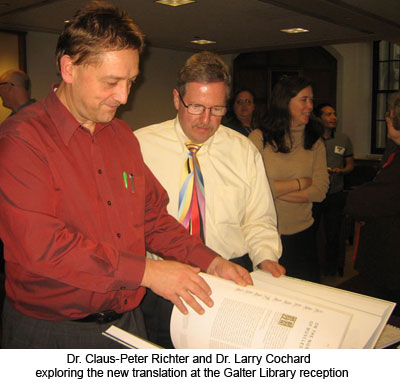By: Linda O'Dwyer and Ronald Sims
In 1993, Malcolm H. Hast, PhD, professor emeritus of otolaryngology-head and neck surgery, and Daniel H. Garrison, PhD, professor emeritus of classics at Northwestern University, began the massive undertaking of translating the 1543 and 1555 editions of Andreas Vesalius’ De Humani Corporis Fabrica (The Fabric of the Human Body). On Monday, November 4, 2013, years of meticulous research and arduous work were celebrated by Northwestern faculty, staff, students, and invited guests at the North American book launch reception at the Galter Health Sciences Library. Similar events were held in Basel, Switzerland, the Frankfurt Book Fair, and at the Royal Society in London.
 The event was sponsored by the medical publishing firm Karger of Basel, Switzerland and was represented by its president, grand-daughter of the founder, Gabriella Karger. A brief program included remarks by Ms. Karger and Donald Lloyd-Jones, MD, ScM, senior associate dean for clinical and translational research and chair of preventive medicine, who thanked the professor emeriti for “bringing this remarkable accomplishment to Northwestern." Concluding remarks were given by Drs. Hast and Garrison.
The event was sponsored by the medical publishing firm Karger of Basel, Switzerland and was represented by its president, grand-daughter of the founder, Gabriella Karger. A brief program included remarks by Ms. Karger and Donald Lloyd-Jones, MD, ScM, senior associate dean for clinical and translational research and chair of preventive medicine, who thanked the professor emeriti for “bringing this remarkable accomplishment to Northwestern." Concluding remarks were given by Drs. Hast and Garrison.
At the age of 28, Vesalius (1514-1564) derived accurate information of the body’s structure and the function of its parts from actual dissections. In contrast to all those before him, who blindly accepted what the old masters had taught, Vesalius began documenting and illustrating only that which he could see himself through human dissections. When published, the 1543 Fabrica drastically differed from any other anatomical text to date and called into question almost everything that the medical profession claimed to know about the human body.
The new translation is the first time that the full text of both editions is available in English and its launch coincides with the 500th anniversary of Vesalius’ birth.
Drs. Hast and Garrison utilized the Galter Library’s 1555 edition for changes in the text of the 1543 edition. The Galter Library’s copy was purchased in August 1934 from the English second-hand bookseller, Lier for $275.00. Then medical school dean, Irving S. Cutter, an avid medical history expert took advantage of the depressed European book market between World War I and II. Many of the treasures in Special Collections are due to his collection diligence and by the donations of personal libraries of faculty members and alumni during and after Dr. Cutter’s deanship.
Originally presented as an electronic text supported by the Northwestern University Library’s Digital Collections Department, a search for a publisher was initiated and Karger Publishers in Basel, Switzerland took the challenge, even going so far as to ask a Swiss font designer to develop a modern rendition of the 16th century typeface. Drs. Garrison and Hast’s work has been funded by grants from the National Endowment for the Humanities, National Library of Medicine, and the Andrew W. Mellon Foundation. The Kuwaiti Government through its Minister of Health underwrote the publication with a $1 million grant. The translated text has gone through many revisions and now appears in the new published version.
The Library’s copy is a gift from Dr. Hast and may be viewed in Special Collections.
For more information on how the emeriti professors collaborated on the translation, see: http://www.feinberg.northwestern.edu/announcements/vesalius.html
Updated: September 25, 2023